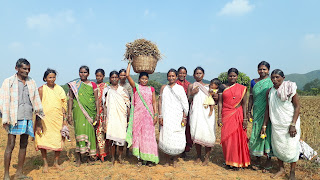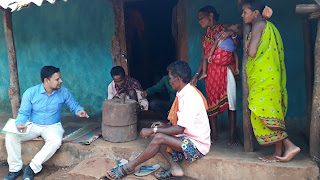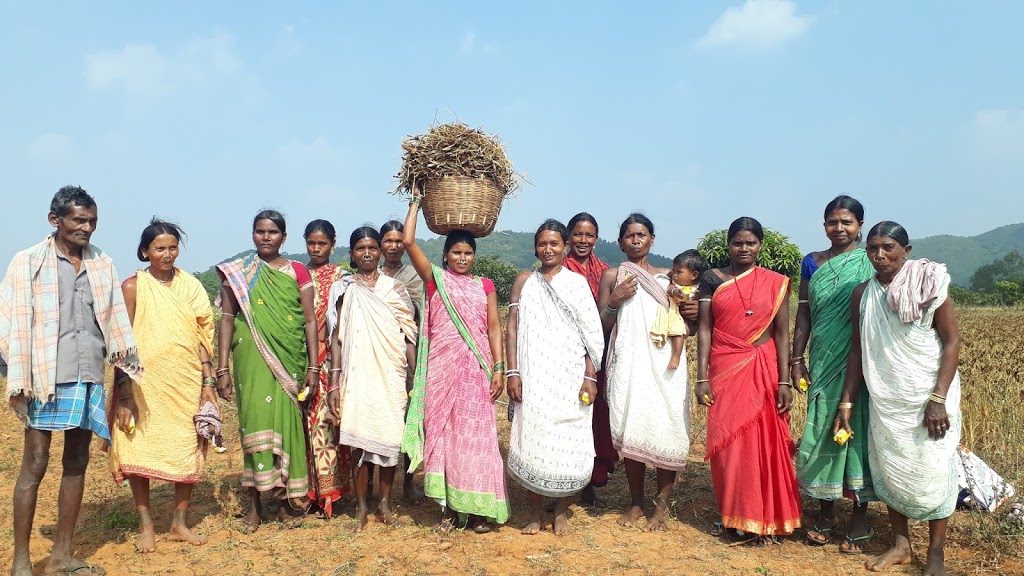To utilize Finger Millet for Nutritional Security we have to focus on the following points in the coming days:
 |
| Crop Cutting of Finger Millet |
1. To increase the production and productivity of Finger Millet:
- Awareness creation on the system of millet intensification(SMI) of finger millet as this the method is giving more yield as compared to traditional methods.
- Conservation of local promising varieties which are giving more yields and sustaining from climate change.
- Giving more priority for weed control as it is the main constraints in Finger Millet production.
- Sowing/transplanting in time will enhance the production and productivity of finger millet.
- More production of finger millet will bring change in the livelihood of the tribal’s by addressing the consumption part and also by selling in the market/mandi.
- Farmers must be encouraged to use the finger millet residue as fodder as it contains more nutrients and fiber.
- Development of context-specific improved varieties to improve productivity, increase shelf-life, improved nutritional content, and promote crop diversity.
2. To address the consumption of finger millet:
 |
| A farmer showing his Ragi Porridge(Mandia Jau in Odia) |
- Consumption of finger millet, every day is a tradition of tribal’s as they keep 75% of their finger millet produces for consumption. It is seen that, the availability of finger millet in their house is almost for 12 months (65% households) but we have to address the rest (35% households) for round the year availability.
- The perception of most households is that they consumed finger millet as it gives more energy than other food and they can easily do the daily routine work and least were unaware of the control of blood sugar.
- Odisha tribals possess traditional knowledge of making different types of recipes from finger millets for ages. But we have to encourage them by organizing a food festival.
- As no modern recipe was available in the market neither they had any idea to make it. Only giving them training time to time will help to build their skill in cooking and simultaneously we can encourage the local entrepreneurs to come out with modern recipes at their local market. It is seen that most of them have the interest to have modern recipes like cakes, biscuits, and ladoos.
 |
| Suggestions to increase the consumption of Finger Millet |
- All recommended to include ragi in mid-day meals and ICDS. The second suggestion (42 sample household) was to include ragi in PDS followed by awareness creation among farmers about health benefits, organizing food mela, an outlet of millet products in the local market, and finally training to farmers. They all had a concern that their children do not take ragi and including in mid-day meals and ICDS will surely address the nutritional security and malnutrition.
-
3. To address the primary and secondary processing of Finger Millet:
 |
| Understanding Traditional Millet Processing |
- 67% of households come under marginal and small farmers and 56% did not have any assets like farm implements, pump sets, motorcycles, and tractors. 86% do their threshing of finger millet manually by using sticks. This can be addressed by establishing community hiring centers and also encouraging entrepreneurs to establish an agriculture service center in the locality.
- Most of the sample household (69 percent) do their milling by using traditional chhaki and rest (30 percent) by pulverizer. It was found that the sample households near to market availed the service of pulverizer. Community pulverizers can address this issue and can simultaneously reduce the drudgery of women.
4. Initiatives are taken under Odisha Millet Mission:
 |
| System of Millet Intensification in Farmer’s Field |
- Around 50,000 farmers have been mobilized to take up millet cultivation with improved agronomic practices. Incentives to farmers for millet cultivation. For SMI its Rs.5000/- per hectare in the first year and in the second year it’s Rs.3000/- per hectare. Similarly, for line sowing/line transplanting its Rs.2500/- per hectare and Rs.1500/- per hectare in the first and second years respectively.
- The State Government has already started the procurement of surplus ragi from the farmers. Last year(2018) around 18,000 quintals of Ragi were procured from farmers @Rs.28.97/kg and in the year(2019) the procurement target was enhanced to one lakh quintal @Rs.31.50/kg and procurement of about 95,000 quintals was done. In this year 2020, the MSP of Ragi is bringing more hope for Small and marginal farmers.
- Introduced supply of 1kg ragi under PDS in addition to 5 kg basket per person entitlement.
- Plans are afoot for the inclusion of millets in supplementary nutrition programs under mid-day meals and ICDS.
- Started public awareness about health, nutritional, environmental & other important benefits of consuming & cultivating millets. Plan to set up decentralized millet processing units in the block and gram panchayat level.
- Plan to form a Farmer Producer Organisation in the block level as this will be an extension arm of government in the future for delivery of services.







1 thought on “Utilisation of Finger Millet in Nutritional Security”